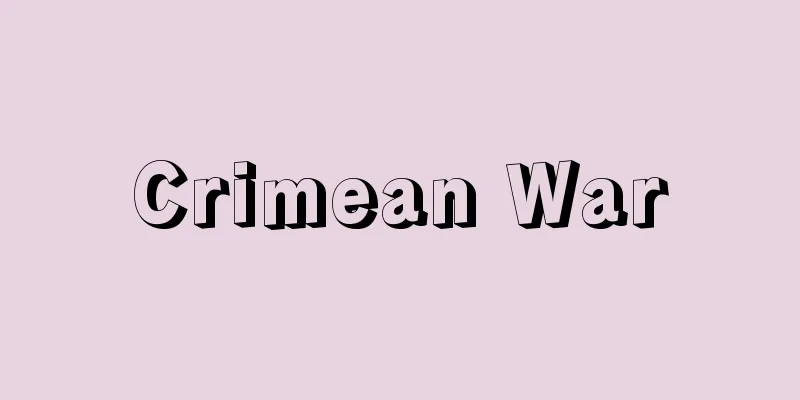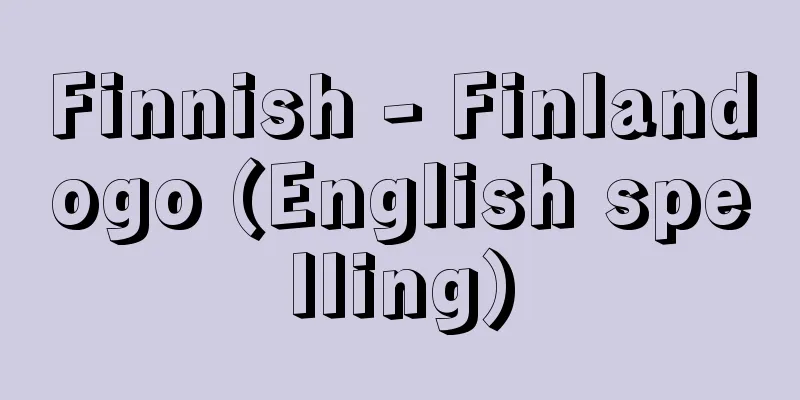Crimean War

|
A war fought between Russia and the allied forces of Turkey, Britain, France, and Sardinia from 1853 to 1856. It was so named because the Crimean Peninsula was the site of the war. [Tsuguo Tonokawa] CauseThe direct cause of the war was when Napoleon III, who wanted to gain popularity for Catholics in France, demanded that the Turkish government take away the management rights of the Holy Land of Bethlehem Church from Greek Orthodox Christians and give them to Catholic priests at the end of 1852, and Turkey gave in. This would have endangered the status of Orthodox Christians living in Turkish territory and would have led to a loss of face for the Russian Tsar, who was the protector of all Orthodox Christians, so Nicholas I sent a special envoy to Turkey and demanded that Turkey restore the management rights of the Holy Land and guarantee the rights of Orthodox Christians. Turkey agreed to the former demand, but rejected the latter, claiming that it was interference in its internal affairs. The Russian government believed that Britain and France were enemies and that there would be no joining hands over this issue. However, Britain, fearing that Russia would advance from the Black Sea to the Aegean Sea, cooperated with France and sent a fleet to the Dardanelles. At this point, Russia sent 80,000 troops into the two principalities of Moldavia and Wallachia, over which Turkey had suzerainty, in early July 1953. In response, Turkey, seeking support from Britain and France, demanded that Russia withdraw, but when this was refused, Turkey declared war on Russia in October of the same year and began attacking Russian forces in the two principalities. [Tsuguo Tonokawa] ProgressIn November 1853, the Russian fleet under the command of Admiral Nakhimov defeated the Turkish Black Sea Fleet in the Battle of Sinop. The defeat of the Turkish Navy prompted the entry of Britain and France into the war, and in March 1854, they declared war on Russia (the Sardinian government later declared war on Russia in January 1855). In September 1854, the Russian forces under General Paskevich, feeling threatened by Austria, withdrew from both principalities, and the Austrian forces occupied them. In the same September, the French, British and Turkish forces landed a large force of about 60,000 in Crimea and besieged Sevastopol. Sevastopol was hastily fortified by General Totleben, and the Russian fleet, forced to admit its weakness compared to the other great powers, sank its own ships in Sevastopol Bay and blocked the port entrance, using the tactics of Black Sea Fleet Commander Kornilov. Meanwhile, the Russian forces on land, with the participation of local residents, managed to hold out against enemy artillery fire for over 11 months, but at the end of August the following year, the Allied forces occupied the southern part of Sevastopol, forcing them to retreat to the north. The war was effectively over by the end of that year. [Tsuguo Tonokawa] resultNicholas I died in February 1855 during the war, but his successor, Alexander II, realized that the Russian military was not capable of continuing the war and that domestic reforms had priority, and concluded a peace treaty in Paris in March 1856 (Treaty of Paris). As a result, Russia ceded the mouth of the Danube and part of Bessarabia, lost the right to possess a fleet in the Black Sea, and dashed any hope of advancing into the Mediterranean. The Black Sea was declared neutral, and free navigation for commerce was permitted in the Bosphorus and Dardanelles, but the passage of warships from all countries was denied. The defeat sparked a movement for modernization within Russia, and a series of reform projects were carried out, beginning with the emancipation of serfs in 1861. The climax of this war was the fierce siege of the fortress of Sevastopol, which lasted for 349 days. L. Tolstoy, then 26 years old, participated in this battle as a lieutenant and wrote "Tales of Sevastopol" while in the camp. In addition, the British nurse Florence Nightingale devoted herself to caring for wounded soldiers, which later gave rise to the momentum of the Red Cross movement. The death toll of the Allied forces in the Crimean Peninsula reached 70,000, while that of the Russian side reached 130,000. [Tsuguo Tonokawa] Source: Shogakukan Encyclopedia Nipponica About Encyclopedia Nipponica Information | Legend |
|
1853年から56年にかけて、ロシアと、トルコ・イギリス・フランス・サルデーニャの連合軍との間で行われた戦争。クリミア半島がその舞台となったところから、こうよばれる。 [外川継男] 原因戦争の直接のきっかけは、フランス国内のカトリックの人気取りを目ざすナポレオン3世が、1852年末トルコ政府に対して、聖地エルサレムのベツレヘム教会の管理権をギリシア正教徒から取り上げてカトリックの司祭に与えるよう要求し、トルコがこれに屈したことにあった。このことは、トルコ領内に住む正教徒の地位を危うくし、また全正教徒の庇護(ひご)者をもって任ずるロシア皇帝の面目失墜にもつながるものであったため、ニコライ1世は特使を派遣、聖地管理権の復活と正教徒の権利の保障とをトルコに要求した。トルコは、前者の要求に応じたが、後者は内政干渉であるとして拒絶した。ロシア政府は、イギリスとフランスとが敵対しており、この件で両国が手を握ることはないとみていた。しかし、ロシアの黒海からエーゲ海方面への進出を恐れるイギリスは、フランスと協同してダーダネルス海峡に艦隊を差し向けた。ここに至ってロシアは、53年7月初め、トルコが宗主権を有していたモルダビアとワラキアの両公国に8万の軍隊を進駐させた。これに対しトルコは、英仏の支援を頼んで、ロシアに撤退を要求したが、これが拒絶されるに及んで、同年10月ロシアに宣戦を布告し、両公国内のロシア軍に攻撃を開始した。 [外川継男] 経過1853年11月、ナヒーモフ提督指揮下のロシア艦隊は、シノップ沖の海戦でトルコの黒海艦隊を破った。トルコ海軍の敗北は、英仏の参戦を促進することとなり、両国は54年3月にロシアに宣戦を布告した(このあと、55年1月にはサルデーニャ政府もロシアに宣戦を布告する)。54年9月、オーストリアの脅威を感じたパスケービッチ将軍麾下(きか)のロシア軍は、両公国から撤退し、オーストリア軍がこれら2公国を占領した。また同じ9月、フランス・イギリス・トルコ軍は約6万の大軍をクリミアに上陸させて、セバストポリを包囲した。セバストポリは、トートレーベン将軍によって急きょ防御工事が施され、また列強側に比べ力の弱さを認めざるをえなかったロシア艦隊は、コルニーロフ黒海艦隊司令官の戦術でセバストポリ湾に自艦を沈めて港口を閉塞(へいそく)した。他方、陸上のロシア軍は、住民の参加も得、よく敵の砲撃に抗して11か月余の長きにわたってセバストポリ要塞(ようさい)を守りぬいたが、翌55年8月末になって、連合軍にセバストポリの南側を占拠され、北方への退却を余儀なくされた。戦争は同年の末までに事実上終わった。 [外川継男] 結果ニコライ1世は戦争中の1855年2月に死去したが、後を継いだアレクサンドル2世は、ロシア軍に戦争継続能力のないこと、国内の改革が優先することを見て取り、56年3月パリにおいて講和を締結した(パリ条約)。これによって、ロシアはドナウ河口とベッサラビアの一部を譲り、黒海に艦隊を所有する権利を失って、地中海方面へ進出する望みを断たれた。黒海は中立を宣せられ、ボスポラス、ダーダネルス両海峡は通商上の自由航行は認められたが、すべての国の軍艦の通過は否定された。ロシア国内では敗戦をきっかけに、近代化を目ざす運動が起こり、61年の農奴解放に始まる一連の改革事業が行われるようになった。 この戦争のクライマックスは、セバストポリの要塞をめぐる349日間の激しい攻防戦であった。当時26歳のL・トルストイは少尉補としてこの戦闘に参加し、陣中で『セバストポリ物語』を書いた。また、イギリスの看護婦ナイチンゲールは傷病兵の看護に尽力し、後年の赤十字運動の機運を生み出した。クリミア半島における連合軍の戦死者は7万、ロシア側は13万にも上った。 [外川継男] 出典 小学館 日本大百科全書(ニッポニカ)日本大百科全書(ニッポニカ)について 情報 | 凡例 |
<<: Crimean Peninsula - Krymskiy Poluostrov (English spelling)
>>: Grimaldi Caves - Grimaldi Caves (English spelling) Grimaldi
Recommend
Indian Seat
It is a constellation located further southwest o...
Kokuhonsha - Kokuhonsha
This right-wing group was founded in May 1924 (Ta...
Sergiev
…A city in the Moscow Oblast, in the west of Euro...
quasistatic process
…In thermodynamics, a narrower definition is that...
Hojutsu - art of magic
〘noun〙① A skill. An art. Also, a method. A means. ...
Onigumo - Onigumo
This spider belongs to the Arthropoda phylum, Ara...
MLD - MLD
Abbreviation for Mac OS Licensing Design. Specific...
Luddite Movement - Luddite Movement
The Luddite Movement was a machine-breaking moveme...
Felipe II - Felipe
King of Spain (reigned 1556-1598). Son of Charles ...
House of Savoy - Savoia (English spelling)
A noble family in northern Italy. They first becam...
Otomo Fuke
A military commander in the late 7th century. Als...
Lizardite
...The name comes from its snakeskin-like appeara...
Archery competition - Entekikyogi
It is a type of archery competition, performed by ...
Leōsthenēs (English spelling) Leosthenes
…When news of Alexander the Great's death rea...
Physiognomy - Kansojutsu
…However, natural magic, which F. Bacon and other...









